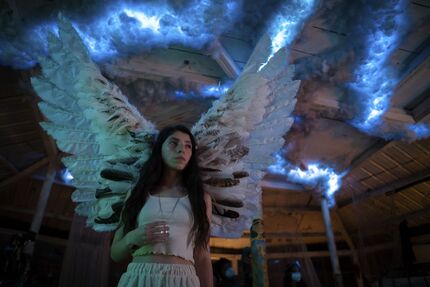Fantasia 2024 Review: RITA, A Magical Realist Tragedy From The Director of LA LLORONA

A young girl endures brutalization at the hands of her caregivers in a Guatemalan home for girls in Rita, director Jayro Bustamante’s eagerly anticipated follow up to the critically acclaimed La Llorona. Bustamante once again draws from his country’s dark past to create a magical realist horror fantasy filled with spirits, faeries, and angels in conflict with the evil that men do. It’s a harrowing, heartbreaking examination of both the oppression of the downtrodden and the exploitation that lead to a real-life 2017 tragedy that claimed the lives of forty-one young girls, and it is exceptional.
When we meet Rita (Giuliana Santa Cruz), she is on her way to an institution designed to care for wayward girls. She’s just run away from her abusive father and was living independently until a poorly timed illness landed her in the hospital where the authorities grabbed her and has decided to place her in custody for her own protection. Immediately upon arrival, Rita understands that her placement is not as benevolent as she foolishly believed it might be, and she’s going to have to be tough to make it through.
Led through the building’s dark corridors to a cramped housing unit, Rita is quickly absorbed by one of several cliques, the angels. She is informed by her roomies, that she must assimilate and stick with her sisters or risk losing their protection and facing the dangers that exist from both the other girls and the guards alone. She reluctantly agrees, and though she still has faith that she’ll somehow make her way out once they realize she’s done nothing wrong, it becomes very apparent that there is more to fear than she’d first realized, and that the only way to guarantee survival for herself or any of her compatriots is escape, but that reprieve is far from certain.
Much like La Llorona harnessed power of horror to examine and share the tragedy of the ‘80s Mayan genocide in Guatemala, Rita also uses horror, though certainly lower key, to expose his country’s dirty secrets to the world. Strongly reminiscent of Guillermo del Toro’s use of fantasy in Pan’s Labyrinth to investigate the brutality of the early days of the Franco regime in Spain, Rita specifically places itself in the realm of the fairy tale.
The character of Rita explicitly states that the events of the film may not have happened exactly as they are shown, but instead how she remembered them, painting the tragedy with a childlike gossamer. Her fellow girls are various types of mystical creatures, each powerful and unknowable, but emotional strong in ways they lack physically. On the other hand, the adults in control are all shown as who they truly are, real monsters, not with horns or special powers, but with cruelty as their weapons. The girls utilize fantasy to help them cope with the real horror and exploitation they are facing at the hands of the authorities, it’s a powerful tool, and one that is beautifully realized in the film.
Bustamante’s decision to cast hundreds of non-actors in the roles of the children pays off tremendously well with performances that lack artifice, instead replacing craft with emotion and a feeling that these children are real people. Rita is supported by a cadre of roommates, but Ángela Quevedo as the tough girl protector Sulmy, Alejandra Vásquez as the quick-witted Baby, and Isabel Aldana as the stubborn, but fierce Terca are the true highlights, with each bringing a unique flavor to their performances. The adults, especially Margarita Kenéfic as the witchy Ernestina, bring a sense of genuine menace to the film, making every moment feel unsafe, even as they proclaim that they are there in service of the girls.
Rita is a remarkably handsome film, with the technical teams firing on all cylinders to create an experience that oscillates between oppressive and fantastical. This is in large part thanks to the brilliant cinematography of Inti Briones (Too Late to Die Young), who utilizes the wide aspect ratio to give the film a sense of claustrophobia, along with a deliberately cold color scheme awash in blues and other oppressive colors to achieve a sense of dread. The score by Pascual Reyes underscores the fantasy elements beautifully, adding a sense of tragedy to events leading up to the heart-breaking conclusion.
Though the film details horrific events in ways close enough to the true tragedy at its core, it barely skirts the horror label, rather placing itself in the world of dark fantasy. Bustamante’s empathy for these girls who have repeatedly been put through the worst violations possible, is evident in their humanity and resilience in a way that shows respect and endears them to the audience. An incredible performance from the debutante Giuliana Santa Cruz, is a clear highlight of this film that rests largely on her very capable shoulders. A powerful experience that both inspires and infuriates, Rita is another outstanding film from Jayro Bustamante, a storyteller with a mission.







